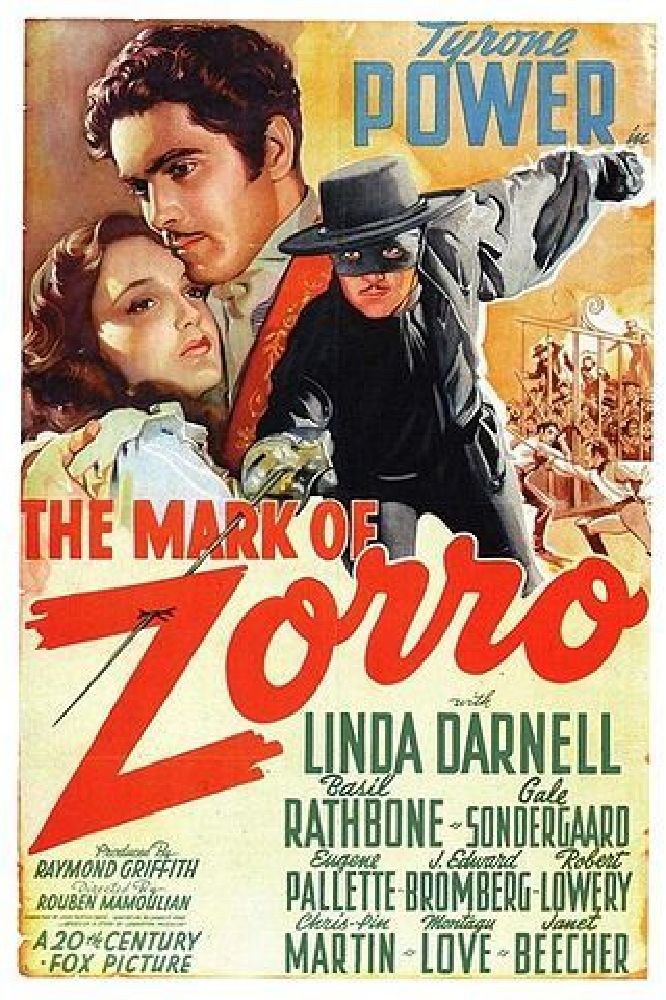
The Mark of Zorro
Swashbuckler movies were prominent in the early silent film era, and retained their popularity into the fifties with the occasional sword fight appearing in recent films. The heroes are strong, charismatic characters who fight for justice and often rescue damsels from ruthless villains.
The Mark of Zorro, produced in 1940 tells the story of one swashbuckler’s escapades in the early nineteenth-century on the American Western frontier.
The sprightly music of the opening scene instantly steals our attention in this movie classic. It conveys the tone of the movie, and the tone matches the actions and temperament of the hero.
Called the 'California cockerel' at the military academy he attends in Madrid, Don Diego Vega displays excellence in riding skills and swordsmanship. He is forced to relinquish his commission when unexpectedly called home by his father, the aristocratic mayor of Los Angeles.
Respectful of his father, Don Diego (Tyron Power) bids his friends goodbye by hurling his sword into the ceiling and proclaiming that in California the custom is that a man will 'marry, raise fat children, and watch his vineyards grow.'
The Franciscan Missions brought Spanish colonial settlers and the cultivation of grapes to the coast of California up from Mexico beginning in the mid eighteenth-century. Diego’s family is of Spanish ancestry and had settled in Los Angles and prospered from the vine prior to his father becoming mayor.
Upon arriving in California, Diego is disturbed to hear the peons speak ill of his father, the alcalde. Don Alejandro Vega had been admired and respected by the peons, but now they speak of hardships caused by the unfair taxes imposed upon them.
All is made clear when Diego enters the home in which he was raised to find that his father has been replaced by Don Luis Quintero. The new alcalde’s military aid, Capitan Esteban Pasquale (Basil Rathbone), a former fencing instructor, displays his ruthlessness by flippantly accentuating his statements with a naked sword.
Fencing held a prominent role in soldiers’ training in Spain. The art of fencing required great skill and developed quick reflexes, mental agility, and bravery. Diego was frequently challenged to duels by other young cadets wishing to brag of the slight injuries inflicted by this admired swordsman.
With quick wit Diego disguises his true character and skills by adopting a foppish persona and flirting with the alcalde’s wife while discussing with her his love of silk, scent, and jewels. For the sake of his plan, Diego continues the charade when he reunites with his parents. Much to the distress of his father and his beloved friar he feigns a complete disinterest in politics.
However, with the youthful aura of confidence and invincibility, Diego wastes no time in avenging the people. Wearing a black mask he robs the alcalde and his wife of a pouch of tax money and a necklace. Leaving an indelible mark sure to be remembered with fear, Diego slices a 'Z' on the alcalde’s coach.
The duel personality of our hero serves him well. As Zorro, the fox, he uses fear to persuade Don Quintero to give up his position and return to Madrid. As Diego, he entices Senora Quintero to return to Madrid by flattering her into believing her beauty, eloquence, and poise would be admired at court.
Zorro narrowly escapes the soldiers’ chase by hiding in the alcalde’s chapel where he encounters Lolita (Linda Darnell), the alcalde’s lovely niece, who is sympathetic to his cause. Keeping the monk’s hood over his face he conceals his identity while he woos her with compliments disguised as spiritual advice. Lolita becomes suspicious and an amusing scene develops.
As the peons’ hardships increase, Zorro’s 'Z' appears on the town bulletin board, the alcalde’s office wall, and a soldier’s bare chest. Consequently, the reward offered for the capture of Zorro increases also.
When Zorro demands that Don Alejandro be reinstated to his former position, the alcalde and the capitan speculate that Zorro is a caballero, a gentleman, and is doing the bidding of Don Alejandro. The capitan suggests an alliance between the two families by proposing the marriage of Lolita and Diego.
Upon meeting Diego, Lolita is disconcerted at the thought of marriage to this prim and vain man. However, she is pleasantly surprised at the thrilling affect of dancing with such an artful, Spanish dancer.
After another theft of tax money, Diego leads a swift chase through the forest but escapes capture by hiding in the church. He bids Friar Felipe (Eugene Pallette) to keep the plunder in the church’s strongbox.
But when the friar is caught with the coins and necklace, he is imprisoned. Diego suffers the same fate when his secret passageway to the alcalde’s office is discovered after a sword fight with Capitan Pasquale.
The people’s resourceful hero uses trickery and charm to gain his and Friar Felipe’s release from jail. Diego’s courage inspires the caballeros and peons to fight side by side for their liberation. And by revealing his true identity, Diego wins the heart of Lolita and vows to fulfill the prophecy of his departing speech in Madrid.
This action-packed swashbuckler is filled with skillful maneuvers on horseback, in magic tricks, on the dance floor, and in spirited sword fights. It is a classic story of the use of quick wit and cunning schemes in the struggle for justice over evil.
The composer of the movie‘s music, Alfred Newman, was nominated for an Oscar for Best Original Score. The legend of Zorro was created in 1919 by the pulp fiction writer, Johnston McCulley. The Mark of Zorro was a remake of the 1920 silent film starring Douglas Fairbanks, Sr. Numerous films featuring Zorro have been produced around the world.

